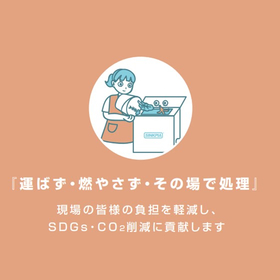Processing the residue generated during the production of fish cakes! No need to carry organic waste outdoors, greatly improving work efficiency.
We would like to introduce a case study regarding the installation of the commercial food waste processor "Sinkpia GJ-100" at Sato Osamu Shoten Co., Ltd. The processor handles the residue generated during the production of kamaboko. The compost-type food waste processor that was previously used was malfunctioning, prompting the search for a new food waste processor. The incineration-type Sinkpia can be installed indoors, eliminating the need to transport food waste outdoors, which significantly improves work efficiency, leading to the decision to implement it. [Case Overview] ■ Handles the residue generated during the production of kamaboko ■ The previously used compost-type food waste processor was malfunctioning, and a new food waste processor was being sought ■ Indoor installation eliminates the need to transport food waste outdoors, greatly improving work efficiency ■ The ability to input food waste as it is generated is also a significant advantage *For more details, please download the PDF or feel free to contact us.
Inquire About This Product
basic information
For more details, please download the PDF or feel free to contact us.
Price range
Delivery Time
Applications/Examples of results
For more details, please download the PDF or feel free to contact us.
catalog(4)
Download All CatalogsCompany information
"What we want you to discard is the conventional wisdom of food waste disposal machines." The development concept of Sink Pia is to process food waste 'without transporting, without burning, and on-site.' By self-processing food waste within facilities, it contributes to CO2 reduction and the SDGs. Japan's food waste disposal, which has relied heavily on incineration, is at a turning point, and many companies are entering the food waste processing machine industry to meet the needs of the times. However, it is also an industry where many companies have been forced to withdraw due to issues related to research and development costs, as well as a lack of knowledge, experience, and skills. Some have already started demonstration experiments, focusing on the development of microbial houses using biodegradable materials, the development of devices for processing dirty biodegradable containers, and further research on resource recovery such as liquid fertilizers and soil conditioners from decomposed water. We aim to be a company that is needed by more customers and can realize a society that is friendly to the future of the Earth's environment.


![[Comprehensive Catalog] Commercial Food Waste Processor Sink Pia](https://image.mono.ipros.com/public/catalog/image/01/e15/355232/IPROS741825587306973971.jpeg?w=120&h=170)
![[Concept Catalog] Commercial Food Waste Processor Sink Pia](https://image.mono.ipros.com/public/catalog/image/01/9fc/355233/IPROS97919348904398666138.jpeg?w=120&h=170)

![[SINKPIA + SDGs] Commercial Food Waste Processor Sinkpia](https://image.mono.ipros.com/public/catalog/image/01/cd6/665665/IPROS41795439056302394625.jpeg?w=120&h=170)





